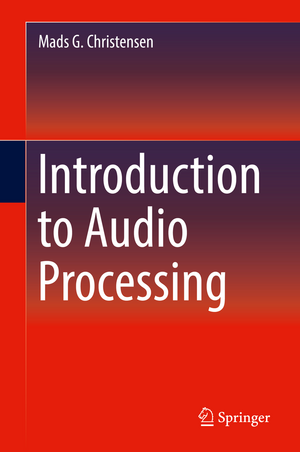Introduction to Audio Processing
Autor Mads G. Christensenen Limba Engleză Hardback – 10 apr 2019
Preț: 531.91 lei
Preț vechi: 625.78 lei
-15% Nou
Puncte Express: 798
Preț estimativ în valută:
101.78€ • 106.55$ • 84.22£
101.78€ • 106.55$ • 84.22£
Carte tipărită la comandă
Livrare economică 05-19 aprilie
Preluare comenzi: 021 569.72.76
Specificații
ISBN-13: 9783030117801
ISBN-10: 3030117804
Pagini: 257
Ilustrații: XXXI, 224 p. 187 illus., 76 illus. in color.
Dimensiuni: 155 x 235 mm
Greutate: 0.54 kg
Ediția:1st ed. 2019
Editura: Springer International Publishing
Colecția Springer
Locul publicării:Cham, Switzerland
ISBN-10: 3030117804
Pagini: 257
Ilustrații: XXXI, 224 p. 187 illus., 76 illus. in color.
Dimensiuni: 155 x 235 mm
Greutate: 0.54 kg
Ediția:1st ed. 2019
Editura: Springer International Publishing
Colecția Springer
Locul publicării:Cham, Switzerland
Cuprins
Introduction.- What is Sound?.- The Wave Equation.- Digital Audio Signals.- What Are Filters?.- Comb Filters and Periodic Signals.- More About Filters.- The Fourier Transform.- Audio Effects.- Spatial Effects.- Audio Equalizers.- Dynamic Range Control.- Pitch Estimation.- Appendix.- Bibliography.
Notă biografică
Mads Græsbøll Christensen received the M.Sc. and Ph.D. degrees in 2002 and 2005, respectively, from Aalborg University (AAU) in Denmark, where he is also currently employed at the Dept. of Architecture, Design & Media Technology as Professor in Audio Processing and is head and founder of the Audio Analysis Lab. He was formerly with the Dept. of Electronic Systems at AAU and has held visiting positions at Philips Research Labs, ENST, UCSB, and Columbia University. He has published 3 books and more than 190 papers in peer-reviewed conference proceedings and journals, and he has given tutorials at EUSIPCO, INTERSPEECH, and SMC. His research interests include signal processing theory and methods with application to speech and audio, in particular parametric analysis, modeling, enhancement, separation, and coding. Prof. Christensen has received several awards, including the Spar Nord Foundation’s Research Prize, a Danish Independent Research Council Young Researcher’s Award, the StatoilPrize, the EURASIP Early Career Award, and an IEEE Signal Processing Society Young Author Best Paper Award (with D. Giacobello). Moreover, he is a beneficiary of major grants from the Danish Independent Research Council, the Villum Foundation, and Innovation Fund Denmark. He is a former Associate Editor for IEEE/ACM Trans. on Audio, Speech, and Language Processing and IEEE Signal Processing Letters, a member of the IEEE Audio and Acoustic Signal Processing Technical Committee, and a Senior Member of the IEEE.
Textul de pe ultima copertă
This textbook presents an introduction to signal processing for audio applications. The author’s approach posits that math is at the heart of audio processing and that it should not be simplified. He thus retains math as the core of signal processing and includes concepts of difference equations, convolution, and the Fourier Transform. Each of these is presented in a context where they make sense to the student and can readily be applied to build artifacts. Each chapter in the book builds on the previous ones, building a linear, coherent story. The book starts with a definition of sound and goes on to discuss digital audio signals, filters, The Fourier Transform, audio effects, spatial effects, audio equalizers, dynamic range control, and pitch estimation. The exercises in each chapter cover the application of the concepts to audio signals. The exercises are made specifically for Pure Data (Pd) although traditional software, such as MATLAB, can be used. The book is intended for students in media technology bachelor programs. The book is based on material the author developed teaching on the topic over a number of years.
- Presents a comprehensive introduction to audio processing for students in media technology and signal processing
- Builds a foundation for audio applications based on mathematical equations, presented in a way understandable to students without a math background
- Includes a full suite of classroom material including end of chapter exercises and companion Youtube video tutorials on the authors’ channel
Caracteristici
Presents a comprehensive introduction to audio processing for students in media technology and signal processing Builds a foundation for audio applications based on mathematical equations, presented in a way understandable to students without a math background Includes a full suite of classroom material including end of chapter exercises and companion Youtube video tutorials on the authors’ channel
